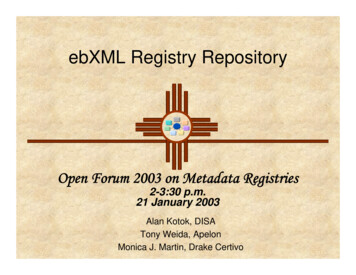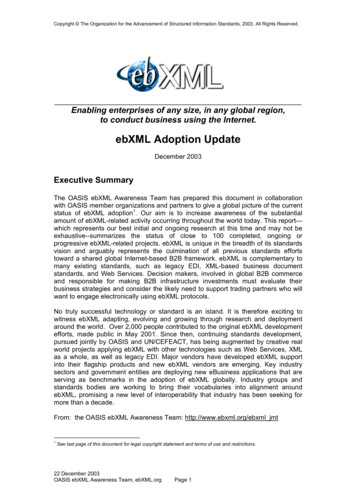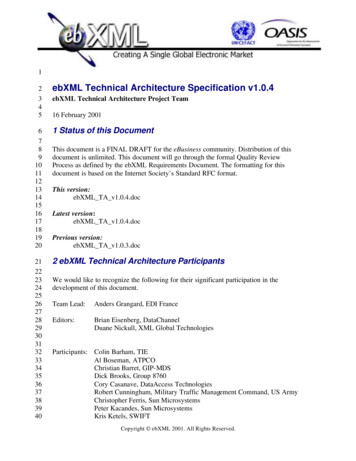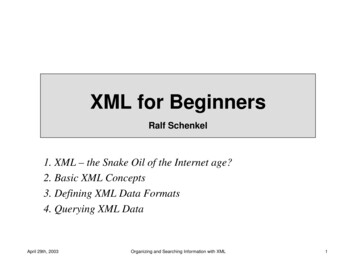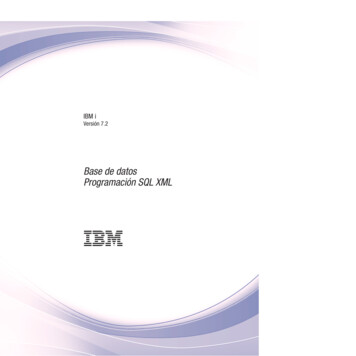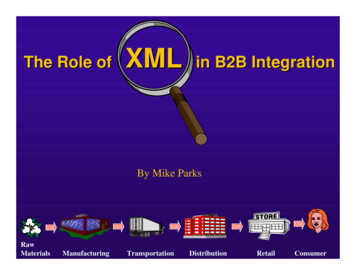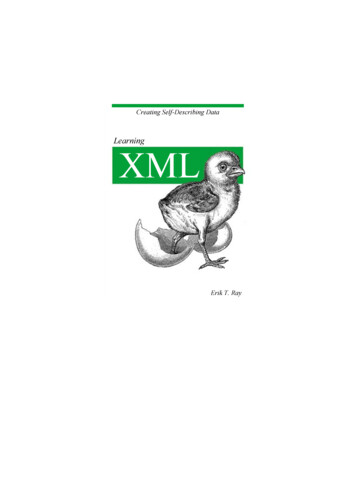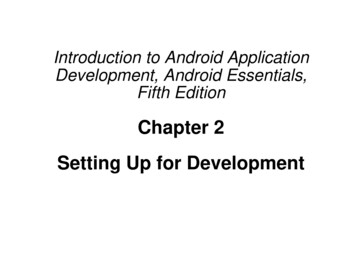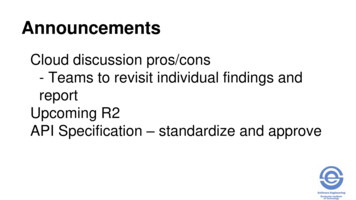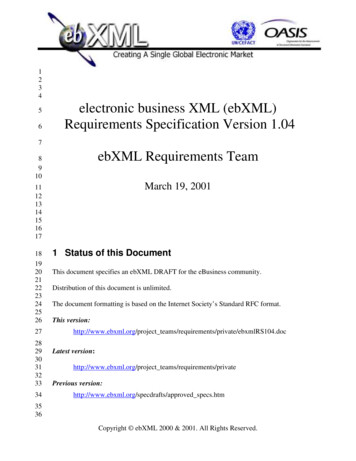
Transcription
123456electronic business XML (ebXML)Requirements Specification Version 1.047ebXML Requirements Team8910March 19, 341 Status of this DocumentThis document specifies an ebXML DRAFT for the eBusiness community.Distribution of this document is unlimited.The document formatting is based on the Internet Society’s Standard RFC format.This version:http://www.ebxml.org/project teams/requirements/private/ebxmlRS104.docLatest version:http://www.ebxml.org/project teams/requirements/privatePrevious version:http://www.ebxml.org/specdrafts/approved specs.htm3536Copyright ebXML 2000 & 2001. All Rights Reserved.
ebXML Requirements 6061626364March 20012 ebXML participantsWe would like to recognize the following for their significant participation to thedevelopment of this document.Mike Rawlins, Rawlins EC Consulting - Team LeaderMark Crawford, Logistics Management Institute - Team EditorDon Rudie, Dun & BradstreetThomas Warner, The Boeing CompanyKenji Itoh, Japan Association for Simplification of International Trade ProceduresJean Kubler, UN/Economic Commission for EuropeKathleen Tyson-Quah, KTQ Consulting LimitedDavid R.R. Webber, XML GlobalGarrett Minakawa, Oracle CorporationTurochas Fuad, Sun Microsystems IncorporatedMurray Maloney, MuzmoDr. Marcia McLure, McLure-Moynihan, Inc.Norbert Mikula, Data ChannelChristopher Lueder, Mitre CorporationScott Hinkelman, International Business MachinesRavi Kackar, Kraft FoodsDoug Hopeman, XML SolutionsGaile L. Spadin, Data Interchange Standards AssociationAdditionally, valuable input was provided from the Team Leaders and various membersof the other ebXML Project Teams.ebXML Requirements SpecificationCopyright ebXML 2000 & 2001. All Rights Reserved.Page 2 of 2
ebXML Requirements March 20013 Table of Contents1234Status of this Document . 1ebXML participants . 2Table of Contents. 3Document Introduction . 54.1 Summary of Contents of Document . 54.2 Audience . 54.3 Related Documents . 54.4 Documentation Conventions. 65General Introduction . 65.1 ebXML Vision and Scope. 75.1.1 ebXML Vision . 75.1.2 ebXML Scope . 75.2 ebXML Requirements Specification Purpose and Scope . 75.2.1 ebXML Requirements Specification Purpose. 75.2.2 ebXML Requirements Specification Scope. 85.3 General ebXML Principles . 86Business Requirements . 106.1 General Business Requirements . 106.2 Conducting Electronic Business using ebXML. 126.3 Globalization. 126.3.1 Openness . 136.3.2 Registry and Repository. 136.4 Usability/Interoperability. 146.4.1 Architecture. 146.4.2 Transport, Routing, & Packaging . 156.4.3 Extensibility . 156.4.4 Leveraging Existing Technology. 156.5 Security . 166.6 Legal . 176.7 Digital Signatures. 186.8 Management. 186.8.1 Organizational Structure . 186.8.2 Participation . 197ebXML Technical Framework Requirements . 20General Requirements. 207.2 Requirements . 217.3 Business Process . 217.4 Technical Architecture. 237.5 Core Components. 247.6 Transport/Routing and Packaging. 257.7 Registry and Repository. 257.7.1 Technical Specification Submission, Development, and Support . 267.7.2 System Services . 27ebXML Requirements SpecificationPage 3 of 3Copyright ebXML 2000 & 2001. All Rights Reserved.
ebXML Requirements arch 20017.8 Trading Partners. 277.9 Proof of Concept . 288ebXML Organizational and Procedural Requirements. 298.1 Executive Committee Support . 308.1.1 Quality Review . 308.1.2 Marketing Awareness . 308.1.3 Project Management . 319ebXML Project Team Deliverables . 329.1 Major ebXML Technical Specifications. 329.2 High Level Deliverables Descriptions . 3310 Disclaimer . 3411 Contact Information . 35Copyright Statement . 36ebXML Requirements SpecificationCopyright ebXML 2000 & 2001. All Rights Reserved.Page 4 of 4
ebXML Requirements TeamMarch 20011224 Document Introduction1234.1 Summary of Contents of Document124125126127This ebXML Requirements Specification represents the work of the ebXML RequirementsProject Team. It defines ebXML and the ebXML effort, articulates business requirementsfor ebXML, and defines specific requirements that shall be addressed by the variousebXML project teams in preparing their deliverables.128129130131132The keywords MUST, MUST NOT, REQUIRED, SHALL, SHALL NOT, SHOULD,SHOULD NOT, RECOMMENDED, MAY, and OPTIONAL, when they appear in thisdocument, are to be interpreted as described in RFC 2119 [Bra97].1331341351361371384.2 1531541551561571584.3 Related DocumentsThe target audiences for this document are: ebXML Project Teams, as a foundation for developing their technical specifications Other interested parties, as a means to convey the purpose, scope, and vision ofebXMLebXML Invitation - http://www.ebXML.org/documents/199909/ebXML invitation.htmebXML Terms of Reference (TOR) http://www.ebXML.org/documents/199909/terms of reference.htmRecommendations for ebXML Kickoff Meeting - UN/CEFACT/TMWG/N104 .pdfTechnical Reports and Publications, World Wide Web Consortium,http://www.w3.org/TRUnited Nations Layout Key for Trade Documents, Recommendation No. 1, secondedition, adopted by the Working Party on Facilitation of International Trade Procedures,Geneva, March 1981 Source: ECE/TRADE/137Authentication of Trade Documents by Means Other Than Signature, RecommendationNo. 14, second edition, adopted by the Working Party on Facilitation of InternationalTrade Procedures, Geneva, March 1979 Source: TRADEWP.4/INF.63ebXML Requirements SpecificationCopyright ebXML 2000 & 2001. All Rights Reserved.Page 5 of 5
ebXML Requirements TeamMarch 2001159160161162163164165Information technology -- Specification and standardization of data elements ISO/IEC[ISO 11179]1661671681691701711721731744.4 Documentation 1881891901911921931941951961971985 General IntroductionSIMAC Future Vision Statement - UN/CEFACT Ad Hoc Working Group on Simple-EDIand Forms and Web Based EDI (SIMAC) - document e/untdid/download/99cp12.pdfThe following highlighting is used for non-normative commentary in this document:[Issue -]: A recorded issue.[Ed. Note -]: Notes from the editors to themselves or the Working Group.[NOTE -]: General comments directed to all readers.Electronic Business Extensible Markup Language (ebXML) is an international initiativeestablished by the United Nations Centre for Trade Facilitation and Electronic Business(UN/CEFACT) and the Organization for the Advancement of Structured InformationStandards (OASIS) with a mandate to undertake a 15-18 month program of work. Asidentified in the ebXML Terms of Reference, the purpose of the ebXML initiative is toresearch and identify the technical basis upon which the global implementation of XMLcan be standardized. The goal is to provide an XML-based open technical framework toenable XML to be utilized in a consistent and uniform manner for the exchange ofelectronic business (eb) data in application to application, application to human, andhuman to application environments—thus creating a single global electronic market. 1ebXML is based on international standards and is itself intended to become aninternational standard. A key aspect for the success of the ebXML initiative is adherenceto the use of the W3C suite of XML and related Web technical specifications to themaximum extent practical. Although these specifications may not provide the optimaltechnical solution, acceptance of ebXML by the business community and technicalcommunity is tied to XML. However, certain key elements of the ebXML technicalframework may require adopting alternative technologies and technical specifications—such as those of the Internet Engineering Task Force (IETF), International Organizationfor Standardization (ISO), Institute of Electrical and Electronics Engineers (IEEE),International Electrotechnical Commission (IEC), UN/CEFACT, OASIS, and the ObjectManagement Group (OMG).1"creating a single global electronic market" is a trademark of the ebXML Working GroupebXML Requirements SpecificationCopyright ebXML 2000 & 2001. All Rights Reserved.Page 6 of 6
ebXML Requirements TeamMarch 2001199200[NOTE - ebXML operates under the procedures identified in the ebXML Terms ofReference]2015.1 ebXML Vision and Scope2022032042052062072082092102115.1.1 ebXML VisionThe ebXML vision is to deliver:"A single set of internationally agreed upon technical specifications that consist ofcommon XML semantics and related document structures to facilitate global trade."This ebXML technical specifications are intended to create a Single Global ElectronicMarket. To create this single global electronic market, this single set of ebXMLtechnical specifications:212213 is fully compliant with W3C XML technical specifications holding arecommended status214215 provides for interoperability within and between ebXML compliant trading partnerapplications216217218 maximizes interoperability and efficiency while providing a transition path fromaccredited electronic data interchange (EDI) standards and developing XMLbusiness standards219220 shall be submitted to an appropriate internationally recognized standards body foraccreditation as an international standard2215.1.2 ebXML Scope222223224225226227The ebXML initiative is targeted at every sector of the business community, frominternational conglomerate to small and medium sized enterprises engaged in business-tobusiness and business-to-consumer trade. With that audience in mind, the ebXMLinitiative is committed to developing and delivering specifications that will be used by alltrading partners interested in maximizing XML interoperability within and across tradingpartner communities.2282292305.2 ebXML Requirements Specification Purpose and ScopeThe ebXML Requirements Specification purpose and scope are defined in the followingsub-sections.2312322335.2.1 ebXML Requirements Specification PurposeThis Requirements Specification has two primary purposes. The first of these is toprovide clearly articulated requirements from representatives of international businessebXML Requirements SpecificationCopyright ebXML 2000 & 2001. All Rights Reserved.Page 7 of 7
ebXML Requirements TeamMarch 2001234235236237and accredited standards organizations. These requirements are intended to serve as afoundation for all other ebXML specifications and should assist the ebXML project teammembers in developing their deliverables in a consistent manner. This specification isalso intended to convey to interested parties the purpose, scope, and vision of ebXML.2382392402412425.2.2 ebXML Requirements Specification ScopeThis ebXML Requirements Specification applies to the work underway within the currentebXML project teams. Each project team has provided input to this document to ensureconsensus with its contents. In addition to the Requirements Project Team, project teamscurrently chartered by the ebXML steering committee are:243 Business Process244 Technical Architecture245 Core Components246 Transport/Routing and Packaging247 Registry and Repository248 Trading Partner249 Proof of Concept250251In addition, the following special management support teams are chartered by theebXML Executive Committee:252 Quality Review253 Marketing Awareness254 Project Management2552562575.3 General ebXML PrinciplesGeneral ebXML principles to be followed in developing ebXML deliverables are tocreate technical specifications that:258 Enable simple, easy and ubiquitous electronic business through use of XML259260 Use approved W3C XML technical specifications to the maximum extentpracticable261262 Provide a global cross-industry open/interoperable standard for business-tobusiness and business-to-consumer tradeebXML Requirements SpecificationCopyright ebXML 2000 & 2001. All Rights Reserved.Page 8 of 8
ebXML Requirements TeamMarch 2001263264 Coalesce the structure and content components of divergent XML initiatives into asingle useable XML business standard265266 Provide impetus so that common resources currently engaged in short-termsolutions shall be marshaled to reach a common long-term solution goal267 Support vertical and horizontal segments of industry and business participants268269270 Avoid proprietary solutions that impose financial or software requirementsconstraints on ebXML users to buy, install or programmatically support anyebXML unique software products in the conduct of business information exchange271 Strive to minimize costs of doing business electronically272 Provide multi-lingual support273 Accommodate national and international trade requirements274275 Provide a migration path from accredited EDI and developing XML businessstandards276277 Apply when possible the simplification principles of SIMAC BusinessRequirements278ebXML Requirements SpecificationCopyright ebXML 2000 & 2001. All Rights Reserved.Page 9 of 9
ebXML Requirements TeamMarch 932942952962972982993003013023033043053063073086 Business RequirementsThis section describes the business requirements for business to be conductedelectronically. The business requirements identified in this section are oriented towardusing XML for electronic business, but most of the requirements are applicable toimplementation with other technologies as well.The scope of the ebXML business requirements is to meet the needs for the business sideof both business to business (B2B) and business to consumer (B2C) activities. Consumerrequirements of the B2C model are beyond the scope of the ebXML technicalspecifications. Application-to-application (A2A) exchanges within an enterprise may alsobe able to use the ebXML technical specifications, however ebXML A2A solutions shallnot be developed at the expense of simplified B2B and B2C solutions.[NOTE - for ease of reading, the term business is to be interpreted as interchangeablewith for-profit, non-profit, not-for profit, and government entities.][NOTE - For the purposes of this document, Application-to-Application is defined as thecomputer to computer exchange of business information without human intervention bothwithin and across enterprise boundaries.]The business requirements to be addressed by the ebXML initiative are divided into ninecore areas - General Business, Electronic Business, Globalization, Openness ,Usability/Interoperability, Security, Legal, Digital Signature, and Organizational. Each ofthese requirements is identified in the following sections.6.1 General Business RequirementsBusiness has a real need to use new technology with minimized investment to gaincompetitive advantage. The advent of the Internet and World Wide Web has proven tooffer such benefits. However, realizing these benefits requires a functionally neutralstandard method of exchanging data. Specifically, business needs a solution thatprovides:309310 A single, consistent, simple approach to using XML for electronic businessprocesses in both the B2B and B2C environments311 A process and recommendation for ebXML conformance312313314 Support for both vertical (e.g. industry, functional, organizational) and horizontal(e.g. cross-industry, multi-functional, organizationally neutral) solutions regardlessof the sophistication of the userebXML Requirements SpecificationCopyright ebXML 2000 & 2001. All Rights Reserved.Page 10 of 10
ebXML Requirements TeamMarch 2001315316317 Support for a range of implementations from basic, low cost solutions appropriatefor Small and Medium Enterprise (SME) deployment, to comprehensive, compleximplementations using all optional features appropriate to large enterprises318319 A range of usage from using core features in ad hoc, informal exchanges to highlyformal, structured exchanges320 A single consistent modeling language and methodology321322 Support for current business models and practices as well as new ones developedthrough business process modeling323324 A superset business process metamodel that supports individually developedbusiness process models325326 Design rules for developing ebXML compliant XML documents that are based onapproved W3C schema specifications327 Syntactically neutral core components328329 XML syntax based core schema's and tags to support individual trading partnerbusiness processes that -330ä eliminate duplication of effort331ä provide support for XML metadata332ä clearly identify core, mandatory features, and optional features333ä provide a mechanism for full specification of semantic meaning334 Fully interoperable transport, routing, and packaging solutions335 Security solutions that meet business confidentiality requirements336337 A single recognized international standards organization to oversee continuedebXML work338 An open development process with no barriers to entry339 Open, readily accessible, perpetually free technical specifications and standards340 A solution that minimizes costs for development, maintenance, and use341342343[NOTE - Business looks to XML as a means of gaining competitive advantage throughleveraging new technology. Minimizing the cost of doing business electronically is a keyelement in achieving a competitive advantage. The cost of doing business electronicallyebXML Requirements SpecificationCopyright ebXML 2000 & 2001. All Rights Reserved.Page 11 of 11
ebXML Requirements TeamMarch 2001344345346347348can be grouped into acquisition, development, deployment and customization, integrationwith business applications, and operations and support. It is expected that using XML forelectronic business will be less costly than traditional forms of EDI and other existingelectronic commerce technologies in each of these areas. This expected cost reduction isa driving force for considering XML over traditional EDI technologies.]3496.2 Conducting Electronic Business using ebXML350351352353354355356357358359360361Business applications need to be able to exchange structured business documents(encoded in XML) with a corresponding application of another enterprise to support abusiness process. This exchange may either be completely without human intervention,as is the case with traditional EDI, or with some level of human intervention to correctmissing or erroneous data. Business applications may also need to exchange structuredbusiness documents with intermediaries such as portals and brokers. Because a majorityof businesses do not have sophisticated IT architectures, business applications will needto exchange structured business documents with trading partners who will be limited toviewing and manually processing both inbound and outbound transactions. Businessapplications also require information exchange mechanisms that provide for the exchangeof pure XML payloads but may also support plug and play, shrink wrapped, syntacticallyneutral solutions.362Additionally, business applications may also need to:363364365366367 Be able to generate XML encoded business documents that can be used intraditional computer to computer exchanges as well as being displayed using anassociated style sheet keyed to a specific presentation format; such as theappropriate U.N. Layout Key for Trade Documents or a trading partner specifiedformat368369370371 Enable data entry of business documents using a specified presentation format;such as the appropriate U.N. Layout Key for Trade Documents or a trading partnerspecified format. The data entry shall result in an ebXML compliant encodeddocument representing the business information.3723733743753763773783793803813826.3 GlobalizationGlobal solutions are critical in today's ever expanding marketplace. The underlyingpurpose of ebXML is to facilitate international trade. To achieve "a single globalelectronic market" that such facilitation implies, it is critical to simplify existingexchange standards methodologies and harmonize divergent approaches. Thissimplification and harmonization can be achieved through developing a businessmetamodel in conjunction with syntax neutral core components. Both of thesedeliverables shall accommodate divergent national and multi-national processrequirements, and should support backward compatibility with the developing ebXMLtechnical framework.ebXML Requirements SpecificationCopyright ebXML 2000 & 2001. All Rights Reserved.Page 12 of 12
ebXML Requirements TeamMarch 2001383384385386387388389390To simplify development efforts, all work shall use English. To support globalization, allebXML technical specifications shall be translatable into other natural languages.Translation into other natural languages is the responsibility of the intended user,although such translations should be supported in the ebXML repository. Regardless oflanguage, and in keeping with the requirements of XML 1.0, all work shall be compliantwith Unicode and ISO/IEC 10646 for characters, Internet RFC 1766 for languageidentification tags, ISO 639 for language name codes, and ISO 3166 for country namecodes.3913923933943953963976.3.1 OpennessOpenness is a critical aspect of ebXML. Business requires the ability to easily accessebXML technical specifications without regard to "membership", or payment of accessand/or use fees. ebXML technical specifications shall be completely open to all potentialusers so as to eliminate the barriers for entry. Openness requires several key componentsto ensure viability. Chief among these is an open, easily accessible registry and repositoryfor the ebXML technical .3.2 Registry and RepositoryA registry is required to allow process owners to submit, classify, register and updatemapping templates, business process specifications, and data interchange specifications.This registry must have an interface that supports access by humans as well as computerapplications. This registry must support an agreed upon security protocol.A repository is required for storage and retrieval of various items that support performingbusiness electronically. There are two distinct sets of business requirements on therepository: a set dealing with managing the workflow of developing standard componentsthat are stored in the repository, and a set dealing with application usage of therepository. Additionally, the repository must support the information needs of theebXML work group and project teams, as well as ebXML technical specification userswith respect to glossaries and products.[NOTE - A registry is a mechanism whereby relevant documents and metadata aboutthem can be registered such that a pointer to their location, and all their metadata, can beretrieved as the result of a query. A repository is a location or a set of distributedlocations where documents pointed at by the registry reside and from which they can beretrieved by conventional (http / ftp) means, perhaps with additionalauthentication/permission layers.]The ebXML Registry and Repository shall support the concept of a network of registriesand repositories that can intercommunicate via the interfaces specified by the ebXMLRegistry and Repository Project Team. A registry can be established by an industry groupor standards organization and can intercommunicate with any number of repositories. Inaddition, context with a repository can reference content within another repository. Theconcept of a single repository is not scalable, nor does it promote the idea of a globalweb.ebXML Requirements SpecificationCopyright ebXML 2000 & 2001. All Rights Reserved.Page 13 of 13
ebXML Requirements Team426427428429430431432433434March 2001If ebXML is to exist beyond its initial 18-month timeframe, then ebXML should maintainresponsibility for ebXML technical specifications, ebXML work group deliverables, andebXML glossaries in an ebXML-supported repository. However, if the decision is madethat ebXML will not exist after the initial set of deliverables, or that ebXML will notmaintain or support its own repository, then ebXML must determine if repositoryoversight responsibilities for ebXML technical specifications should transition toUN/CEFACT, OASIS, XML.ORG, BizTalk, or some other existing XML businessstandards organization or consortium4354364374384396.4 Usability/Interoperability4404414426.4.1 ArchitectureThis is a primary requirement of the ebXML initiative. To maximize interoperability, theebXML architecture should supportUsability and interoperability of the ebXML technical framework are critical businessrequirements. Components of usability and interoperability are architecture; transport,routing, and packaging; extensibility; and leveraging existing technology. Each of theseis addressed in the following sub-sections.443444 Common Business Processes - Both entities involved in the exchange of data mustbe engaged in executing the same transaction in the context of a business process445446 Common Semantics – Common meaning, as distinct from words, expression, o
236 members in developing their deliverables in a consistent manner. This specification is 237 also intended to convey to interested parties the purpose, scope, and vision of ebXML. 238 5.2.2 ebXML Requirements Specification Scope 239 This ebXML Requirements Specification applies to the work underway within the current 240 ebXML project teams.
